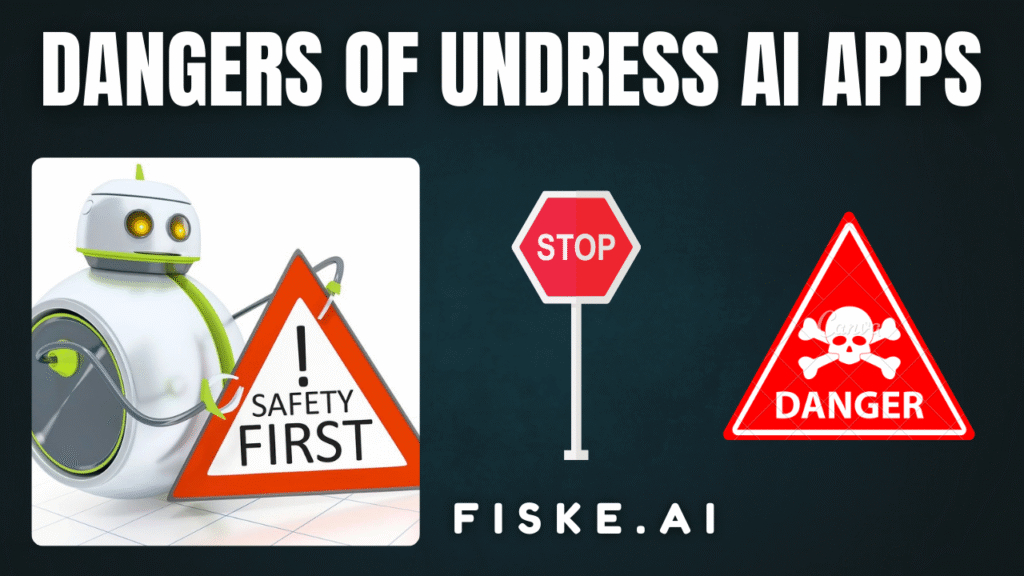A new and dangerous trend is circulating online: applications and websites that claim to use Artificial Intelligence (AI) to digitally undress ai a person from a photo. Marketed as a harmless bit of fun, the reality is that these tools are a gateway to serious digital harm, privacy violations, and even criminal activity.
If you’ve wondered whether these apps are safe, the answer is a clear and absolute NO.

This guide will explain exactly why these applications are so dangerous and, most importantly, provide actionable steps on how you can protect yourself and others from this form of digital exploitation.
Part 1: The Direct Answer – Are Undress AI Apps Safe?
Let’s be unequivocal: Undress AI applications are fundamentally unsafe and dangerous. They pose a triple threat that puts the user, the victims in the photos, and the wider community at significant risk. There is no scenario where using them is harmless.
Engaging with these apps exposes you to:
- Severe Cybersecurity Risks: Infecting your own devices with malicious software.
- Devastating Harm to Victims: Participating in a form of digital sexual abuse.
- Serious Legal Consequences: Committing acts that are felonies in many states.
Turn Your Ideas Into Viral Videos – Instantly!
✨ Create stunning AI-generated videos & images in seconds.
No editing skills? No problem. Just type, and Fiske.ai brings your vision to life!🎬 Start for FREE → https://fiske.ai
Part 2: Understanding the Triple Threat – The Dangers Explained
To truly understand the danger, let’s break down the three core risks of using these applications.
1. Cybersecurity Risks to YOU, The User
These apps are not available on official stores like the Google Play Store or Apple App Store for a good reason—they are often traps. By downloading or visiting these platforms, you risk:
- Malware and Spyware: Many of these apps are bundled with malicious software designed to steal your personal information, including banking details, passwords, and private messages.
- Data Theft: You could be handing over access to your entire photo gallery, contact list, and social media accounts.
- Blackmail: The creators of the app may record your activity and use it to blackmail you, threatening to expose your use of the service to your contacts.
2. Devastating Harm to Victims
The primary function of these apps is to create non-consensual explicit images. This is not a victimless act; it is a form of Image-Based Sexual Abuse (IBSA).
- Profound Violation of Privacy: It strips individuals of their dignity and control over their own bodies.
- Severe Psychological Trauma: Victims often experience intense anxiety, depression, public humiliation, and fear. The emotional and psychological impact can be long-lasting.
- Fueling Exploitation: The images created can be used for harassment, bullying, and blackmail, causing irreparable damage to a person’s reputation, relationships, and professional life.
3. Serious Legal Consequences in the United States
The legal landscape regarding this technology is evolving rapidly. While there isn’t one single federal law criminalizing the act, the legal risks are severe and growing:
- State Laws: A growing number of states, including California, New York, Texas, and Virginia, have passed specific laws that make creating or distributing non-consensual deepfake pornography a crime, often a felony.
- Federal Action: The Violence Against Women Act (VAWA) Reauthorization Act of 2022 established the right for victims to sue the creators of these images in federal civil court.
- Existing Laws: Even without specific “deepfake” laws, this activity can be prosecuted under existing statutes related to harassment, stalking, or the distribution of obscene materials.
Engaging in this activity could lead to felony charges, significant fines, and imprisonment.
Part 3: Your Guide to Staying Safe from Digital Exploitation
Now for the most important part: how to protect yourself and what to do if you or someone you know becomes a victim.
How to Protect Your Images and Privacy
The best defense is a proactive one. Here’s how to make your online presence more secure:
- Audit Your Social Media Privacy: Set your social media profiles (Instagram, Facebook, etc.) to private. Only accept follow requests from people you know and trust.
- Be Mindful of What You Post: Avoid posting high-resolution photos in public forums where they can be easily downloaded. Think twice before sharing images that reveal personal information.
- Disable Location Tagging: Turn off geotagging on your photos to avoid sharing your location.
- Trust Your Instincts: Be wary of sharing personal photos with anyone, even in private chats, as you lose control of where they might end up.
What to Do If You Become a Victim in the USA
If someone has created or shared a manipulated, explicit image of you, it is not your fault. You have the right to take action.
- Do Not Engage: Do not reply to the person who has shared or created the image. They are often seeking a reaction.
- Document Everything: Take screenshots of the images, the conversation, and the profiles of the people involved. This is crucial evidence.
- Report on the Platform: Immediately report the image and the user account to the social media platform (Facebook, Instagram, WhatsApp, etc.) for violating their community standards on harassment and non-consensual imagery.
- Report to Law Enforcement:
- Start by filing a report with your local police department.
- File a complaint with the FBI’s Internet Crime Complaint Center (IC3) online at ic3.gov.
- If the victim is a minor, it must be reported immediately to the National Center for Missing & Exploited Children (NCMEC) through their CyberTipline.
- Seek Support: You are not alone. Reach out to organizations like the Cyber Civil Rights Initiative, which runs a crisis helpline for victims.
Turn Your Ideas Into Viral Videos – Instantly!
✨ Create stunning AI-generated videos & images in seconds.
No editing skills? No problem. Just type, and Fiske.ai brings your vision to life!🎬 Start for FREE → https://fiske.ai
Conclusion
The curiosity surrounding ‘undress AI’ apps is understandable, but the potential for devastating harm is undeniable. These tools are not harmless fun; they are weapons for digital abuse, data theft, and criminal activity.
By choosing to avoid them entirely, protecting your digital privacy, and supporting victims, you contribute to a safer and more respectful online environment for everyone.
FAQs
Are undress AI apps illegal in the USA?
Yes, in many states they are illegal and can be prosecuted as a felony. A growing number of states have specific laws against creating or sharing non-consensual deepfake images. Federally, victims also have the right to sue the creators in civil court.
What’s the biggest risk of just trying one of these apps once?
The single biggest risk is malware. A single visit or download can infect your device with spyware designed to steal your personal data, including banking information, passwords, and private photos, opening you up to financial fraud or personal blackmail.
What is the very first thing I should do if I find a fake image of myself?
Do not panic and do not contact the abuser. Your first step should be to take screenshots of the image and any related messages as evidence. This documentation is crucial for reporting it to the platform and to law enforcement like your local police or the FBI’s IC3.
How can I make my social media photos safer from misuse?
The most effective step is to set your social media profiles (like Instagram and Facebook) to “Private.” This ensures that only people you approve can see your photos, drastically reducing the risk of them being stolen and used maliciously.
Where can victims get help and support in the US?
Beyond law enforcement, victims can get help from non-profits like the Cyber Civil Rights Initiative, which offers a crisis helpline. If the victim is under 18, the National Center for Missing & Exploited Children (NCMEC) is the primary resource for support and reporting.





